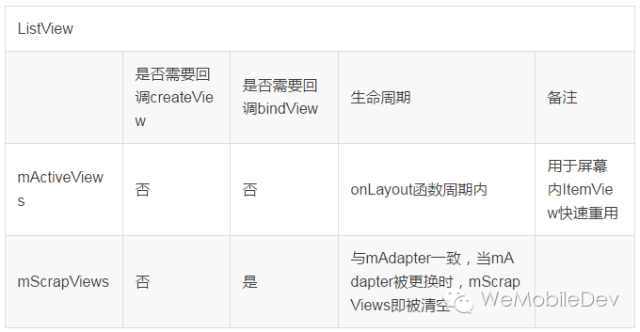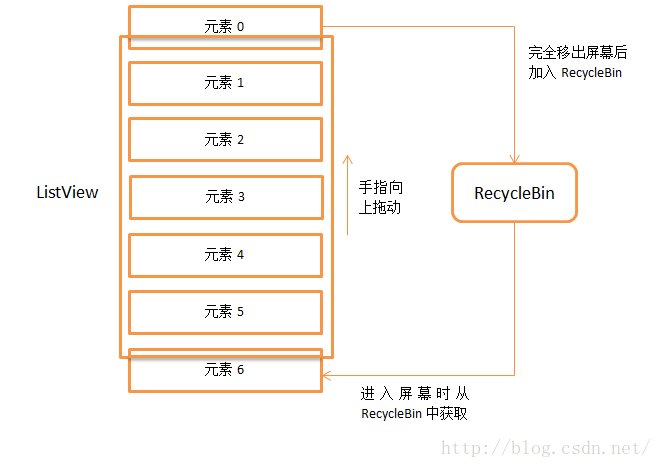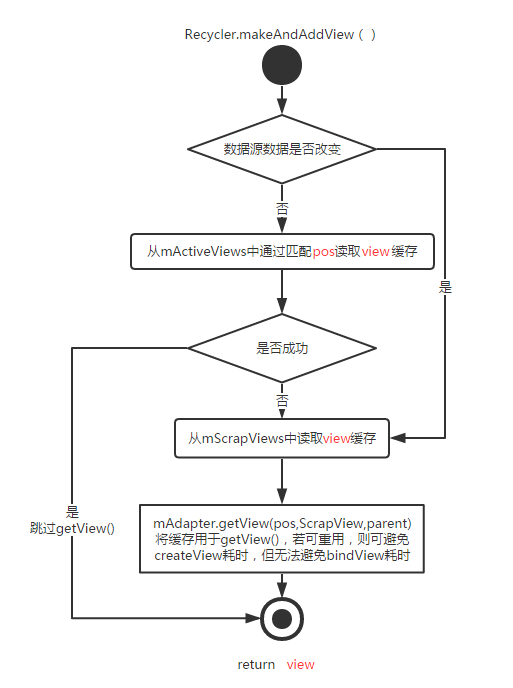[TOC]
## RecycleBin机制

```
/**
* The RecycleBin facilitates reuse of views across layouts. The RecycleBin
* has two levels of storage: ActiveViews and ScrapViews. ActiveViews are
* those views which were onscreen at the start of a layout. By
* construction, they are displaying current information. At the end of
* layout, all views in ActiveViews are demoted to ScrapViews. ScrapViews
* are old views that could potentially be used by the adapter to avoid
* allocating views unnecessarily.
*
* @see android.widget.AbsListView#setRecyclerListener(android.widget.AbsListView.RecyclerListener)
* @see android.widget.AbsListView.RecyclerListener
*/
class RecycleBin {
private RecyclerListener mRecyclerListener;
/**
* The position of the first view stored in mActiveViews.
*/
private int mFirstActivePosition;
/**
* Views that were on screen at the start of layout. This array is
* populated at the start of layout, and at the end of layout all view
* in mActiveViews are moved to mScrapViews. Views in mActiveViews
* represent a contiguous range of Views, with position of the first
* view store in mFirstActivePosition.
*/
private View[] mActiveViews = new View[0];
/**
* Unsorted views that can be used by the adapter as a convert view.
*/
private ArrayList<View>[] mScrapViews;
private int mViewTypeCount;
private ArrayList<View> mCurrentScrap;
/**
* Fill ActiveViews with all of the children of the AbsListView.
*
* @param childCount
* The minimum number of views mActiveViews should hold
* @param firstActivePosition
* The position of the first view that will be stored in
* mActiveViews
*/
void fillActiveViews(int childCount, int firstActivePosition) {
if (mActiveViews.length < childCount) {
mActiveViews = new View[childCount];
}
mFirstActivePosition = firstActivePosition;
final View[] activeViews = mActiveViews;
for (int i = 0; i < childCount; i++) {
View child = getChildAt(i);
AbsListView.LayoutParams lp = (AbsListView.LayoutParams) child.getLayoutParams();
// Don't put header or footer views into the scrap heap
if (lp != null && lp.viewType != ITEM_VIEW_TYPE_HEADER_OR_FOOTER) {
// Note: We do place AdapterView.ITEM_VIEW_TYPE_IGNORE in
// active views.
// However, we will NOT place them into scrap views.
activeViews[i] = child;
}
}
}
/**
* Get the view corresponding to the specified position. The view will
* be removed from mActiveViews if it is found.
*
* @param position
* The position to look up in mActiveViews
* @return The view if it is found, null otherwise
*/
View getActiveView(int position) {
int index = position - mFirstActivePosition;
final View[] activeViews = mActiveViews;
if (index >= 0 && index < activeViews.length) {
final View match = activeViews[index];
activeViews[index] = null;
return match;
}
return null;
}
/**
* Put a view into the ScapViews list. These views are unordered.
*
* @param scrap
* The view to add
*/
void addScrapView(View scrap) {
AbsListView.LayoutParams lp = (AbsListView.LayoutParams) scrap.getLayoutParams();
if (lp == null) {
return;
}
// Don't put header or footer views or views that should be ignored
// into the scrap heap
int viewType = lp.viewType;
if (!shouldRecycleViewType(viewType)) {
if (viewType != ITEM_VIEW_TYPE_HEADER_OR_FOOTER) {
removeDetachedView(scrap, false);
}
return;
}
if (mViewTypeCount == 1) {
dispatchFinishTemporaryDetach(scrap);
mCurrentScrap.add(scrap);
} else {
dispatchFinishTemporaryDetach(scrap);
mScrapViews[viewType].add(scrap);
}
if (mRecyclerListener != null) {
mRecyclerListener.onMovedToScrapHeap(scrap);
}
}
/**
* @return A view from the ScrapViews collection. These are unordered.
*/
View getScrapView(int position) {
ArrayList<View> scrapViews;
if (mViewTypeCount == 1) {
scrapViews = mCurrentScrap;
int size = scrapViews.size();
if (size > 0) {
return scrapViews.remove(size - 1);
} else {
return null;
}
} else {
int whichScrap = mAdapter.getItemViewType(position);
if (whichScrap >= 0 && whichScrap < mScrapViews.length) {
scrapViews = mScrapViews[whichScrap];
int size = scrapViews.size();
if (size > 0) {
return scrapViews.remove(size - 1);
}
}
}
return null;
}
public void setViewTypeCount(int viewTypeCount) {
if (viewTypeCount < 1) {
throw new IllegalArgumentException("Can't have a viewTypeCount < 1");
}
// noinspection unchecked
ArrayList<View>[] scrapViews = new ArrayList[viewTypeCount];
for (int i = 0; i < viewTypeCount; i++) {
scrapViews[i] = new ArrayList<View>();
}
mViewTypeCount = viewTypeCount;
mCurrentScrap = scrapViews[0];
mScrapViews = scrapViews;
}
}
```
这里的RecycleBin代码并不全,我只是把最主要的几个方法提了出来。那么我们先来对这几个方法进行简单解读,这对后面分析ListView的工作原理将会有很大的帮助。
* fillActiveViews() 这个方法接收两个参数,第一个参数表示要存储的view的数量,第二个参数表示ListView中第一个可见元素的position值。RecycleBin当中使用mActiveViews这个数组来存储View,调用这个方法后就会根据传入的参数来将ListView中的指定元素存储到mActiveViews数组当中。
* getActiveView() 这个方法和fillActiveViews()是对应的,用于从mActiveViews数组当中获取数据。该方法接收一个position参数,表示元素在ListView当中的位置,方法内部会自动将position值转换成mActiveViews数组对应的下标值。需要注意的是,mActiveViews当中所存储的View,一旦被获取了之后就会从mActiveViews当中移除,下次获取同样位置的View将会返回null,也就是说mActiveViews不能被重复利用。
* addScrapView() 用于将一个废弃的View进行缓存,该方法接收一个View参数,当有某个View确定要废弃掉的时候(比如滚动出了屏幕),就应该调用这个方法来对View进行缓存,RecycleBin当中使用mScrapViews和mCurrentScrap这两个List来存储废弃View。
* getScrapView 用于从废弃缓存中取出一个View,这些废弃缓存中的View是没有顺序可言的,因此getScrapView()方法中的算法也非常简单,就是直接从mCurrentScrap当中获取尾部的一个scrap view进行返回。
* setViewTypeCount() 我们都知道Adapter当中可以重写一个getViewTypeCount()来表示ListView中有几种类型的数据项,而setViewTypeCount()方法的作用就是为每种类型的数据项都单独启用一个RecycleBin缓存机制。实际上,getViewTypeCount()方法通常情况下使用的并不是很多,所以我们只要知道RecycleBin当中有这样一个功能就行了。
## 缓存机制
### 显示
```
private View makeAndAddView(int position, int y, boolean flow, int childrenLeft,
boolean selected) {
View child;
if (!mDataChanged) {
// Try to use an exsiting view for this position
child = mRecycler.getActiveView(position);
if (child != null) {
// Found it -- we're using an existing child
// This just needs to be positioned
setupChild(child, position, y, flow, childrenLeft, selected, true);
return child;
}
}
// Make a new view for this position, or convert an unused view if possible
child = obtainView(position, mIsScrap);
// This needs to be positioned and measured
setupChild(child, position, y, flow, childrenLeft, selected, mIsScrap[0]);
return child;
}
View obtainView(int position, boolean[] isScrap) {
isScrap[0] = false;
View scrapView;
scrapView = mRecycler.getScrapView(position);
View child;
if (scrapView != null) {
child = mAdapter.getView(position, scrapView, this);
if (child != scrapView) {
mRecycler.addScrapView(scrapView);
if (mCacheColorHint != 0) {
child.setDrawingCacheBackgroundColor(mCacheColorHint);
}
} else {
isScrap[0] = true;
dispatchFinishTemporaryDetach(child);
}
} else {
child = mAdapter.getView(position, null, this);
if (mCacheColorHint != 0) {
child.setDrawingCacheBackgroundColor(mCacheColorHint);
}
}
return child;
}
```
1. 从RecycleBin当中快速获取一个active view
2. 从RecycleBin的getScrapView()方法来尝试获取一个废弃缓存中的View
### 滑出屏幕
当ListView向下滑动的时候,就会进入一个for循环当中,从上往下依次获取子View,第47行当中,如果该子View的bottom值已经小于top值了,就说明这个子View已经移出屏幕了,所以会调用RecycleBin的addScrapView()方法将这个View加入到废弃缓存当中


## 参考资料
[Android ListView工作原理完全解析,带你从源码的角度彻底理解](https://blog.csdn.net/guolin_blog/article/details/44996879)
- Android
- 四大组件
- Activity
- Fragment
- Service
- 序列化
- Handler
- Hander介绍
- MessageQueue详细
- 启动流程
- 系统启动流程
- 应用启动流程
- Activity启动流程
- View
- view绘制
- view事件传递
- choreographer
- LayoutInflater
- UI渲染概念
- Binder
- Binder原理
- Binder最大数据
- Binder小结
- Android组件
- ListView原理
- RecyclerView原理
- SharePreferences
- AsyncTask
- Sqlite
- SQLCipher加密
- 迁移与修复
- Sqlite内核
- Sqlite优化v2
- sqlite索引
- sqlite之wal
- sqlite之锁机制
- 网络
- 基础
- TCP
- HTTP
- HTTP1.1
- HTTP2.0
- HTTPS
- HTTP3.0
- HTTP进化图
- HTTP小结
- 实践
- 网络优化
- Json
- ProtoBuffer
- 断点续传
- 性能
- 卡顿
- 卡顿监控
- ANR
- ANR监控
- 内存
- 内存问题与优化
- 图片内存优化
- 线下内存监控
- 线上内存监控
- 启动优化
- 死锁监控
- 崩溃监控
- 包体积优化
- UI渲染优化
- UI常规优化
- I/O监控
- 电量监控
- 第三方框架
- 网络框架
- Volley
- Okhttp
- 网络框架n问
- OkHttp原理N问
- 设计模式
- EventBus
- Rxjava
- 图片
- ImageWoker
- Gilde的优化
- APT
- 依赖注入
- APT
- ARouter
- ButterKnife
- MMKV
- Jetpack
- 协程
- MVI
- Startup
- DataBinder
- 黑科技
- hook
- 运行期Java-hook技术
- 编译期hook
- ASM
- Transform增量编译
- 运行期Native-hook技术
- 热修复
- 插件化
- AAB
- Shadow
- 虚拟机
- 其他
- UI自动化
- JavaParser
- Android Line
- 编译
- 疑难杂症
- Android11滑动异常
- 方案
- 工业化
- 模块化
- 隐私合规
- 动态化
- 项目管理
- 业务启动优化
- 业务架构设计
- 性能优化case
- 性能优化-排查思路
- 性能优化-现有方案
- 登录
- 搜索
- C++
- NDK入门
- 跨平台
- H5
- Flutter
- Flutter 性能优化
- 数据跨平台
